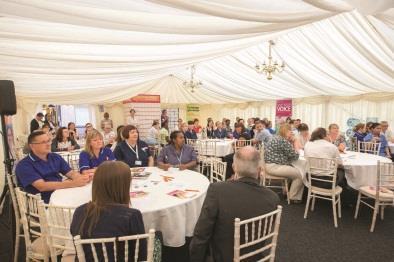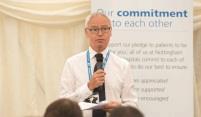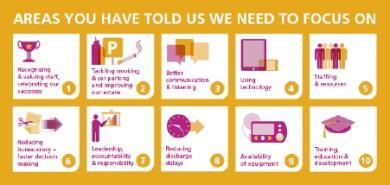After engaging 6,000 patients, carers and staff through 215 ‘events in tents’, one trust has developed a richer game plan on how to improve. Chief executive Peter Homa explains

Eight years into my role as chief executive of Nottingham University Hospitals Trust, and after 24 years as an NHS chief executive, one of the challenges I continue to set myself is working on the basis that whatever one is doing, there is always a better way.
‘Pushing ourselves and one another to be more imaginative and find better solutions is crucial’
The culture we are developing at our hospitals is one of continuous improvement.
We constantly strive to progress through learning when things go wrong. We harness ideas and best practice from around the world. And we encourage innovation and ideas from our patients and staff.
This ensures we keep focused on striving to do an ever better job for our patients, their loved ones and their carers.
- Look from the outside in: Patient opinion can encourage staff
- Patients are a virtue: Learning not to fear feedback
- The new way for trusts to improve staff engagement
Feedback at scale
Amid the frenetic worlds in which we operate, it is easy to continue to do things the way we have always done, such are the increasing demands on our time. The urgent can easily extinguish time for the important. However, pushing ourselves and one another to always be more imaginative in our approach to challenges, and finding better solutions is crucial.
‘Changing the conversational environment helped us to look at challenges from different perspectives’
We made a clear commitment last summer at Nottingham to listen in a very different way to the views of our patients and their carers, volunteers, partners and staff. We held the biggest engagement events of their kind since our organisation was formed in 2006.
We talked to around 6,000 patients and their carers, members, partners and staff over a five week period to achieve two goals:
- to say “thank you” to staff for all they do and recognise that, even though we face challenges, we have come a long way over the past eight years; and
- to listen to views about what we do well and where we can do better.
Engaging with the workforce on a whole hospital scale is powerful. It has brought together the senior team with all staff and further integrated the board with frontline staff. Everyone has been part of the same conversation.

It has also brought together patients and staff. We have seen our organisation from different perspectives, and put ourselves in colleagues’ and patients’ shoes.
Following 215 events, 3,200 pledges for action and 8,500 comments, we have gained some of the most valuable feedback to shape the future of our hospitals. This is, I think, patient and staff engagement at its best.
It is vital to invest time talking and listening to patients and staff. We change our view of the world one conversation at a time. Having these discussions in a different environment to that which we are accustomed makes
a difference.
Quick wins
We had the conversations with our patients and staff in giant marquees at what we called “events in the tents” on our hospital grounds.
Changing the setting changed the nature of the discussions. It broke down barriers, and helped us to have richer dialogue about where we are now and where we need to get to fulfil our privilege and responsibility to do our best for patients.
‘We’ve stayed in touch with how we are doing and how we can do better’
Changing the environment helped us to look at our challenges and the views of our patients from different perspectives.
Through these conversations, we have been able to make some “quick wins” to improve the way we do things.
Immediately after the final event in the tent, we began a 10-week communications exercise to update everyone about the work underway, or soon to start, in the 10 areas in which they told us we needed to do better:
- recognising and valuing staff, celebrating our successes;
- tackling smoking and car parking, and improving our estate;better communication and listening;
- using technology;
- staffing and resources;
- reducing bureaucracy - faster decision making;
- leadership accountability and responsibility;
- reducing discharge delays;
- availability of equipment; and
- training, education and development.
Alongside this engagement work, we commissioned an external audit by Leeds University Business School to give us an evidence based insight into the views of our patients, partners, local politicians, commissioners and staff on how we “live our values”.
Five years on from introducing the values within our trust that form who we are and give a compass to guide decision making, the process was a “temperature check”.

Gold dust
We asked our patients and staff who attended the events in the tents what being the best NHS trust means to them. Overwhelmingly, we were told this means delivering excellent patient care.
We also sought views on how we get there, with the majority saying it is mostly about motivating staff and making them feel appreciated.
‘Our values are at the heart of what we do and the decisions we make’
Pressures and challenges make it all the more important to check the culture and temperature of the organisation. Exploring how our trust is perceived both inside and outside the organisation means we firmly stay in touch with how we are doing and how we can do better.
Our external audit confirmed our values have started to become embedded. They are at the heart of what we do and the decisions we make.
We do have more work to do to consistently live our values between one another (with our colleagues), as well as with our patients. We will work with our patients and staff to help our values mature and develop further. This is valuable feedback. And, when added to the gold dust we collected at the events in the tents, it has put us in good shape to move into the next chapter of our journey to be the best acute teaching trust in England.
Peter Homa is chief executive of Nottingham University Hospitals Trust



























2 Readers' comments